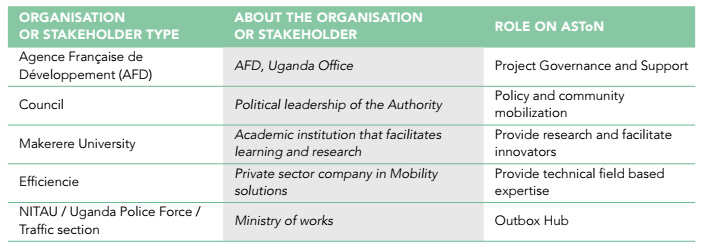Mobility
Focus area for ASToN
 Kampala’s chosen theme is Mobility
Kampala’s chosen theme is Mobility
Kampala like many cities faces a challenge of traffic congestion, which escalates at peak hours. The average speed of vehicles in the Greater Kampala Metropolitan Area is just under 26 km/h implying most of the time drivers are in traffic. Indeed, it is estimated that over 24,000 hours of labor are lost every year from traffic jams alone. Congestion is therefore an economic problem as well as a transport issue for Kampala, as traffic affects mobility of people, goods and services, travel costs, damages the environment in form of pollution and overall productivity in the city. The causes of traffic are numerous, but mostly related to lack of information on road activity.
Findings: the starting point for addressing these problems
Based on research conducted over the course of Phase 1 of the project, interlinked strengths and challenges are taken into account while addressing traffic management.
Limited dissemination of real time traffic information with citizens
The existence of inharmonious traffic information increases the congestion rates in the city. To drive this home there are non-recurrent congestion-causing factors including, but not limited to, traffic accidents, road constructions, vehicle breakdowns, unpredictable weather conditions, sports and entertainment events. The occurrence of any of these incidents is not relayed to road users in real time. This later leads to increased travel costs and inability to forecast travel time.
There are many players in the transport sector without coordination
There are diverse private sector players in Kampala, such as Uber and Safeboda, who capitalize on a large market of road users and demand for public transportation. KCCA has been limited in its ability to manage traffic, and the players in this sector.
Digital and physical transport infrastructure remains limited despite other improvement around the city
While there have been recent projects to improve transport infrastructure, such as the traffic control center, there is a lack of specialized IT equipment to support transport projects and limited traditional transport infrastructure such as parking spaces, roads, traffic lights.
Lack of human capital in the authority is mitigated by strong leadership
KCCA suffers low human resources in terms of staff numbers and skills (particularly in areas such as change management). However, KCCA has a clear background in conducting digital projects, and in forming the partnerships needed to conduct them. There is also potential within IT hubs and academic institutions that can be utilized and high ambition from the city leadership for transforming KCCA services.
In light of the emerging digital trends across the globe, citizens await digital cost-centric solutions
The majority of citizens in Kampala use the internet leading to increased demand for e-services and increased interaction between the authority and citizens on digital platforms. There are concerns from the ASToN Local Group on citizen uptake of any new software or application, with an emphasis on accessibility, convenience, and cost taking lead.
Taking into account the meager financing faced by the authority
There is limited funding for digital development within KCCA, meaning the cost of digital systems is a threat to project ambition. It is also unclear where potential grant opportunities could be available.
Scalability of the current traffic data
KCCA has notable success using traffic data that have resulted in slightly lower traffic delays at the major junctions during peak hours, in respect to the traffic control center. The cost of managing data, as well as maintaining new digital systems are seen as barriers to project implementation.
Next steps
The ASToN project is seen as an integral part of the digital transformation strategy for Kampala. There is a key output component of the IT Strategy focusing on mobility.
Departments of the authority involved in the project

Stakeholders involved in the ASToN Local Group

Participating in the ASToN network



